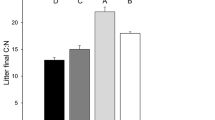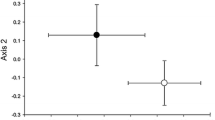Abstract
Consumer growth determines the quantity of nutrients transferred through food webs. The extent to which leaf composition and consumer physiology interact to constrain consumer production is not well understood. For example, detritivore growth, and thus material transfer, could change with detrital elemental composition. Detrital type and associated microbial biofilms can mediate the amount and rate of detritus consumed and used towards growth. Detritivore body stoichiometry or the threshold elemental ratio, the food ratio resulting in optimal growth, may predict taxon-specific growth response to stoichiometrically-altered detritus. Empirical measures of detritivore growth responses across a range of detrital stoichiometry are rare. We fed a common detritivore, Tipula abdominalis, maple or oak leaves that spanned a gradient of carbon:phosphorus (C:P) to examine how leaf identity and C:P interact to influence growth, consumption, assimilation efficiencies, and post-assimilatory processes. Tipula abdominalis growth and consumption varied with leaf type and stoichiometry. Individuals fed oak grew faster and ate more compared to individuals fed maple. Individuals fed maple grew faster and ate more as leaf C:P decreased. All individuals lost most of the material they assimilated through respiration and excretion regardless of leaf type or leaf stoichiometry. Consumption and growth rates of T. abdominalis increased with maple nutrient enrichment, but not oak, indicating leaf-specific nutrient enrichment affected leaf palatability. Slightly non-homeostatic T. abdominalis C:P was maintained by varied consumption, carbon assimilation, and P excretion. Our study underlines the importance of how detritivore consumption and post-assimilatory processing could influence whole-stream material storage and nutrient cycling in detrital-based ecosystems.






Similar content being viewed by others
References
Aber J, Nadelhoffer K, Steudler P, Melillo J (1989) Nitrogen saturation in northern forest ecosystems. Bioscience 39:378–386
Aneja MK, Sharma S, Fleischmann F et al (2006) Microbial colonization of beech and spruce litter-influence of decomposition site and plant litter species on the diversity of microbial community. Microb Ecol 52:127–135. doi:10.1007/s00248-006-9006-3
Back J a, King RS (2013) Sex and size matter: ontogenetic patterns of nutrient content of aquatic insects. Freshw Sci 32:837–848. doi:10.1899/12-181.1
Bärlocher F, Kendrick B (1975) Assimilation efficiency of Gammarus pseudolimnaeus (Amphipoda) feeding on fungal mycelium or autumn-shed leaves. Oikos 26:55–59
Bärlocher F, Porter C (1986) Digestive enzymes and feeding strategies of three stream invertebrates. J North Am Benthol Soc 5:58–66
Benke A, Wallace J (1980) Trophic basis of production among net-spinning caddisflies in a southern Appalachian stream. Ecology 61:108–118
Berg B, Staaf H (1980) Decomposition rate and chemical changes of Scots pine needle litter II. Influence of chemical composition. Ecol Bull 32:373–390
Bobbink R, Hicks K, Galloway J et al (2010) Global assessment of nitrogen deposition effects on terrestrial plant diversity: a synthesis. Ecol Appl 20:30–59
Boersma M, Elser JJ (2006) Too much of a good thing: on stoichiometrically balanced diets and maximal growth. Ecology 87:1325–1330
Boersma M, Aberle N, Hantzsche FM et al (2008) Nutritional limitation travels up the food chain. Int Rev Hydrobiol 93:479–488. doi:10.1002/iroh.200811066
Bullejos FJ, Carrillo P, Gorokhova E et al (2014) Shifts in food quality for herbivorous consumer growth: multiple golden means in the life history. Ecology 95:1272–1284. doi:10.1890/13-0410.1
Cebrian J (2004) Role of first-order consumers in ecosystem carbon flow. Ecol Lett 7:232–240. doi:10.1111/j.1461-0248.2004.00574.x
Cross WF, Benstead JP, Rosemond AD, Bruce Wallace J (2003) Consumer-resource stoichiometry in detritus-based streams. Ecol Lett 6:721–732. doi:10.1046/j.1461-0248.2003.00481.x
Cross W, Wallace J, Rosemond A, Eggert S (2006) Whole-system nutrient enrichment increases secondary production in a detritus-based ecosystem. Ecology 87:1556–1565
Cross W, Wallace J, Rosemond A (2007) Nutrient enrichment reduces constraints on material flows in a detritus-based food web. Ecology 88:2563–2575
Cummins K, Klug M (1979) Feeding ecology of stream invertebrates. Annu Rev Ecol Syst 10:147–172
Cummins K, Wilzbach M, Gates D et al (1989) Shredders and riparian vegetation. Bioscience 39:24–30
DeMott W, Gulati R, Siewertsen K (1998) Effects of phosphorus-deficient diets on the carbon and phosphorus balance of Daphnia magna. Limnol Oceanogr 43:1147–1161
Eggert SL, Wallace JB (2007) Wood biofilm as a food resource for stream detritivores. J North Am Benthol Soc 52:1239–1245
Elser J, Urabe J (1999) The stoichiometry of consumer-driven nutrient recycling: theory, observations, and consequences. Ecology 80:735–751
Elser JJ, Schampel JH, Kyle M et al (2005) Response of grazing snails to phosphorus enrichment of modern stromatolitic microbial communities. Freshw Biol 50:1826–1835. doi:10.1111/j.1365-2427.2005.01453.x
Entrekin SA, Rosi-Marshall EJ, Tank JL, Hoellein T, Lamberti GA (2007) Macroinvertebrate secondary production in forested sand-bottom streams of the Upper Midwest. J North Am Benthol Soc 26(3):472–490
Evans-White MA, Stelzer RS, Lamberti GA (2005) Taxonomic and regional patterns in benthic macroinvertebrate elemental composition in streams. Freshw Biol 50:1786–1799. doi:10.1111/j.1365-2427.2005.01455.x
Evans-White MA, Dodds WK, Huggins DG, Baker DS (2009) Thresholds in macroinvertebrate biodiversity and stoichiometry across water-quality gradients in Central Plains (USA) streams. J North Am Benthol Soc 28:855–868. doi:10.1899/08-113.1
Frost P, Evans-White M, Finkel Z et al (2005) Are you what you eat? Physiological constraints on organismal stoichiometry in an elementally imbalanced world. Oikos 109:18–28
Frost PC, Benstead JP, Cross WF et al (2006) Threshold elemental ratios of carbon and phosphorus in aquatic consumers. Ecol Lett 9:774–779. doi:10.1111/j.1461-0248.2006.00919.x
Gulis V (2001) Are there any substrate preferences in aquatic hyphomycetes? Mycol Res 105:1088–1093
Gulis V, Suberkropp K (2003a) Leaf litter decomposition and microbial activity in nutrient-enriched and unaltered reaches of a headwater stream. Freshw Biol 48:123–134
Gulis V, Suberkropp K (2003b) Interactions between stream fungi and bacteria associated with decomposing leaf litter at different levels of nutrient availability. Aquat Microb Ecol 30:149–157
Hall R, Meyer JL (1998) The trophic significance of bacteria in a detritus-based stream food web. Ecology 79(6):1995–2012
Halvorson H, Scott J, Sanders A, Evans-White M (2015) A stream insect detritivore violates common assumptions of threshold elemental ratio bioenergetics models. Freshw Sci 34 (in press)
Herbst G (1980) Effects of burial on food value and consumption of leaf detritus by aquatic invertebrates in a lowland forest stream. Oikos 35:411–424
Huberty AF, Denno RF (2006) Consequences of nitrogen and phosphorus limitation for the performance of two planthoppers with divergent life-history strategies. Oecologia 149:444–455. doi:10.1007/s00442-006-0462-8
Hutchens J, Benfield E, Webster J (1997) Diet and growth of a leaf-shredding caddisfly in southern Appalachian streams of contrasting disturbance history. Hydrobiologia 346:193–201
Kögel-Knabner I (2002) The macromolecular organic composition of plant and microbial residues as inputs to soil organic matter. Soil Biol Biochem 34:139–162
Mackey A (1977) Growth and development of larval Chironomidae. Oikos 28:270–275
Martin M, Martin J, Kukor J, Merritt R (1980) The digestion of protein and carbohydrate by the stream detritivore, Tipula abdominalis (Diptera, Tipulidae). Oecologia 46:360–364
Martin M, Kukor J, Martin J et al (1981) Digestive enzymes of larvae of three species of caddisflies (Trichoptera). Insect Biochem 11:501–505
McManamay RA, Webster JR, Valett HM, Dolloff CA (2011) Does diet influence consumer nutrient cycling? Macro invertebrate and fish excretion in streams. J North Am Benthol Soc 30:84–102. doi:10.1899/09-152.1
Merritt R, Ross D, Larson G (1982) Influence of stream temperature and seston on the growth and production of overwintering larval black flies (Diptera: Simuliidae). Ecology 63:1322–1331
Petersen R, Cummins K (1974) Leaf processing in a woodland stream. Freshw Biol 4:343–368
Roeding C, Smock L (1989) Ecology of macroinvertebrate shredders in a low-gradient sandy-bottomed stream. J North Am Benthol Soc 8:149–161
Schindler DW (1978) Factors regulating phytoplankton production and standing crop in the world’s freshwaters. Limnol Oceanogr 23:478–486. doi:10.4319/lo.1978.23.3.0478
Scott EE, Prater C, Norman E et al (2013) Leaf-litter stoichiometry is affected by streamwater phosphorus concentrations and litter type. Freshw Sci 32:753–761. doi:10.1899/12-215.1
Simpson S, Raubenheimer D (2012) The nature of nutrition: a unifying framework from animal adaptation to human obesity. Princeton University Press, Princeton
Sinsabaugh R, Linkins A, Benfield E (1985) Cellulose digestion and assimilation by three leaf-shredding aquatic insects. Ecology 66:1464–1471
Small G, Wares J, Pringle C (2011) Differences in phosphorus demand among detritivorous chironomid larvae reflect intraspecific adaptations to differences in food resource stoichiometry across lowland tropical streams. Limnol Oceanogr 56:268–278
Stelzer RS, Lamberti GA (2001) Effects of N: P ratio and total nutrient concentration on stream periphyton community structure, biomass, and elemental composition. Limnol Oceanogr 46:356–367
Sterner RW, Elser JJ (2002) Ecological Stoichiometry. Princeton University Press, Princeton
Sterner R, Hagemeier D, Smith W, Smith R (1993) Phytoplankton nutrient limitation and food quality for Daphnia. Limnol Oceanogr 38:857–871
Suberkropp K, Godshalk G, Klug M (1976) Changes in the chemical composition of leaves during processing in a woodland stream. Ecology 57:720–727
Tant CJ, Rosemond AD, First MR (2013) Stream nutrient enrichment has a greater effect on coarse than on fine benthic organic matter. Freshw Sci 32:1111–1121. doi:10.1899/12-049.1
Taylor M (1989) Compensation for variable food nitrogen by larvae of the salvinia moth. Funct Ecol 3:407–416
Urabe J, Watanabe Y (1992) Possibility of N or P limitation for planktonic cladocerans: an experimental test. Limnol Oceanogr 37:244–251
Van Horn D, Sinsabaugh R, Takacs-Vesbach C et al (2011) Response of heterotrophic stream biofilm—communities to a gradient of resources. Aquat Microb Ecol 64:149–161. doi:10.3354/ame01515
Wallace J, Eggert S, Meyer J, Webster J (1999) Effects of resource limitation on a detrital-based ecosystem. Ecol Monogr 69:409–442
Webster J, Benfield E (1986) Vascular plant breakdown in freshwater ecosystems. Annu Rev Ecol Syst 17:567–594
Woodward G, Gessner MO, Giller PS et al (2012) Continental-scale effects of nutrient pollution on stream ecosystem functioning. Science 336:1438–1440. doi:10.1126/science.1219534
Acknowledgments
The National Science Foundation (DEB 1020076) funded this research. The authors thank Halvor Halvorson, Jasmine Gilbert, Erin Grantz, and J. Thad Scott for laboratory assistance and use. Bob Hall and two anonymous reviewers provided value comments that improved the quality of the manuscript.
Author information
Authors and Affiliations
Corresponding author
Additional information
Communicated by Joel Trexler.
Electronic supplementary material
Below is the link to the electronic supplementary material.
Rights and permissions
About this article
Cite this article
Fuller, C.L., Evans-White, M.A. & Entrekin, S.A. Growth and stoichiometry of a common aquatic detritivore respond to changes in resource stoichiometry. Oecologia 177, 837–848 (2015). https://doi.org/10.1007/s00442-014-3154-9
Received:
Accepted:
Published:
Issue Date:
DOI: https://doi.org/10.1007/s00442-014-3154-9




